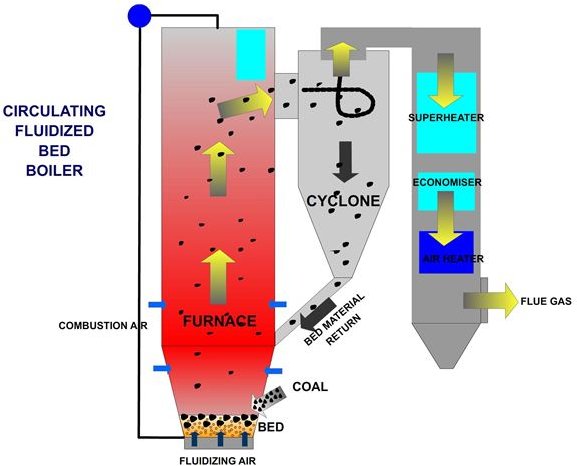Benefits of Circulating Fluidized Bed Systems - Keda Clean Energy Co., Ltd.
by Rudy P. SysAdmin at howtofindthemoney
Process flow introduction:
Circulating fluidized bed gasification system is mainly composed of coal gasification system, desulfurization system, gas pressurization system, pneumatic conveying system, water treatment system and distributed control system, etc.
After crushing and sieving, the pieces coal (size≤10mm) is carried to coal scuttle by the belt conveyors, and then conveyed to gasifier; reacts with the gasification agent which was preheated to 720℃ by heat exchanger I, reaction temperature is about 950℃ in the gasifier, streams are in the fluidization state, and the coal is heated evenly. So the tar, phenol and cyanide decompose completely under the high temperature.
Raw coal gas flows through cyclone separator, heat exchanger I, heat exchanger II, fly-ash filter and heat exchanger III for cooling down and dedusting. At last the coal gas can be sent to users after desulphurization and pressurization.
Features:
- Clean: H2S ≤ 20mg/Nm3, dust ≤ 10mg/Nm3 in the coal gas;
- Efficient: gasification rate of pulverized coal ≥ 3Nm3/kg, comprehensive utilization rate of coal ≥ 90%.
- Low operation cost: pieces coal can be used, it’s not necessary to use lump coal, reducing greatly production cost of coal gas.
- Gasification method: air or oxygen- enriched air as gasification agent.

Process flow introduction:
Based on the clean coal gasification technology realizing cascade conversion, the company has developed a new coal gasification technology, i.e. entrained-flow gasification system, this system use the pulverized coal gasification technology. It is mainly composed of coal mill system, pulverized coal gasification system, pneumatic conveying system, water treatment system and distributed control system, oxygen generation system, etc.
After treated by coal mill system, pulverized coal is conveyed to the burner by nitrogen, mix and reacts (oxidation-reduction) with the gasification agent in the gasifier, and the molten slag flows into the slag pool.
Raw gas flows through gasifier bottom to enter heat exchangers (I, II, III, IV), fly-ash filter and desulfurization system for cooling down, dedusting and desulphurization, at last the clean gas is sent to users.
Features:
- Clean: good pollution control, H2S ≤ 20mg/Nm3, dust ≤ 10mg/Nm3 in the coal gas;
- Efficient: high gasification reaction temperature, liquid slagging, low fly ash content, carbon conversion rate ≥ 98%;
- Wide coal adaptability: using pulverized coal gasification technology, wide coal utilization demand;
- Gasification method: oxygen-enriched air or pure oxygen;
Compared to high pressure entrained-flow gasification technology, such as Shell and Texaco, the technology is matched with the downstream users’ technological process, and the construction and operation cost are greatly decreased.
The 10 largest coal producers and exporters in Indonesia:
Sponsor Ads
Created on Jul 7th 2019 08:45. Viewed 551 times.




clean energy - Sustainable energy is energy produced and used in such a way that it "meets the needs of the present without compromising the ability of future generations to meet their own needs." It is similar to the concepts of green energy and, 'clean energy' in its consideration of environmental impacts, however formal definitions of sustainable energy also include economic and social impacts.
The energy transition to meet the world's needs for electricity, heating, cooling, and power for transport in a sustainable way is widely considered to be one of the greatest challenges facing humanity in the 21st century. Production and consumption of energy emits over 70% of the human-caused greenhouse gas emissions that cause climate change. Worldwide, nearly a billion people lack access to electricity, and around 3 billion rely on smoky fuels such as wood, charcoal, or animal dung to cook. These and fossil fuels are major contributors to air pollution, which causes an estimated seven million deaths per year.
In general, renewable energy sources such as solar, wind, and hydroelectric energy are widely considered to be sustainable. However, aspects of some renewable energy projects, such as the clearing of forests for the production of biofuels, can lead to similar worse environmental damage than using fossil fuel energy. Nuclear power is a low-carbon source and has a safety record comparable to wind and solar, but radioactive waste and the risk of major accidents are disadvantages of this technology.
Moderate amounts of wind and solar energy, which are variable energy sources, can be integrated into the electrical grid without additional infrastructure such as grid energy storage and demand-response measures. These sources generated 8.5% of worldwide electricity in 2019, a share that has grown rapidly. Costs of wind, solar, and batteries are projected to continue falling due to innovation and economies of scale from increased investment.
Proposed pathways for limiting, 'global warming' to 1.5 °C describe the rapid implementation of low-emission methods of producing electricity and heat, and a shift towards more use of electricity in sectors such as transport. The pathways also include measures to reduce energy consumption; and the use of low-carbon fuels, such as hydrogen produced by renewable electricity, Vs. fossil fuel subsidies?
Feb 22nd 2021 14:39 Edited in Feb 22nd 2021 14:49